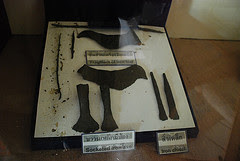The second day of our trip started in Kanchanaburi, where we headed north towards U-Thong, another Dvaravati site. Before we got there, though, we turned down a small side road until we came to a school with a small building off in the corner.


The small building turned out to be a museum, however it was locked. The key was, fortunately, with a person at the school on the same grounds. It turns out that there had been an excavation, and a small museum had been erected to house the artifacts found. Unfortunately, it is unclear just who is responsible for the museum, so it has not been kept up very well. However, we were able to handle some amazing artifacts that the man from the school simply handed around. One was a bracelet approximately 2,000 years old. While the decrepit state of the facilities was lamentable, the opportunity to be that close to history was incredible.
We next traveled to U-Thong. Like many Dvaravati sites, it was surrounded by an irregular moat. The ruins of this chedi (above) were actually on the outside of the moat, surrounded by urban development (as it probably had been for centuries). There is more to be discovered here, but most of it is occupied by squatters, making it difficult to access.


The museum at U-Thong is very much worth the visit. I was doubly impressed because they allowed us to take photos. They have excellent examples of Dvaravati art, including some incredible rare bronze Buddha statues.
Continuing on our tour is like moving forward through the centuries. In Suphanburi, the moat around the old city is almost rectangular, much like later moated cities. Wat Pra Si Rattana Mahatat was once the central temple of the complex, with a Khmer style prang still visible at the back of the current temple complex. Much of the complex relief work can still be seen on the visible plaster.
While at Wat Pra Si Rattana Mahatat, we were fortunate to be able to view an ordination ceremony--one of the happiest moments in a man's life. The entire community comes together for these festivals, and it is a joyous occassion. This parade was traveling clockwise around one of the temple buildings--I believe it was the viharn. The ordination candidate was being carried around beneath a large umbrella, throwing out candy and lucky coins (little 1 Baht coins with a ribbon tied on).
We continued our journey to two temples: Wat Pratu San and Wat Makham No. These temples both contain excellent examples of Lao, Thai, and Chinese influences in the murals all along the inside walls. The primary artist was a displaced Lao brought back from wars in the east in the late 18th, early 19th centuries. He was brought here to work, where he found his brother was also working nearby. Together they both created works that are still admired today.
Our last visit was to Wat Pa Lelai Worawihan, an ancient temple still in use. Much of the temple is new or reconstructed--including this seated Buddha which was built where, it is believed, an ancient Buddha statue once sat. It is, today, one of the most recognizable symbols of this region, and draws a plethora of pilgrims and tourists at all times of the year.

Carved into the plaster of the walls to either side were this monkey and elephant, reverencing the Buddha. These two animals are apparently a common symbol in Buddhist temples.
With nothing more on the itinerary, we returned to Bangkok and the modern world. This has truly been an incredible trip, and I am sure you will here of many more in future posts.
The Archaic of Thailand (Part II)
Stokis HPAI Jogja, Tuesday, May 12, 2009
Subscribe to:
Post Comments (Atom)


Comments :
Post a Comment